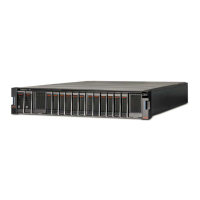FlashSystem 900 Product Guide 15
Encryption Rekey
Rekeying is the process of creating a new key for the system. To create new keys, encryption must be
enabled on the system. However, the rekey operation works whether there are encrypted arrays or not.
Before creating a new key, ensure that the canisters are online and at least one USB port contains a USB
flash drive that contains the current key. During the rekey process, new keys are generated and copied to
the USB flash drives. These keys are then used instead of the current keys. The rekey operation fails if at
least one USB flash drive does not contain the current key. To rekey the system, you need at least three
USB flash drives to store the copied key material.
For more information see the FlashSystem 900 Knowledge Center at:
https://ibm.biz/fs
900
kc
Note: The FlashSystem 900 Knowledge Center will be live on 20th March.
Batteries
Battery reconditioning feature that calibrates the gauge that reports the amount of charge on the batteries.
On systems that have been installed for 10 months or more, or systems that have experienced several
power outages, the recommendation to run "battery reconditioning" will appear in the Event Log shortly
after upgrading.
Note: During the battery reconditioning cycle, no concurrent code upgrades can be performed. See the
FlashSystem 900 Knowledge Center for more information at
https://ibm.biz/fs
900
kc.
System management
The management modules in FlashSystem 900 storage system are processor complexes in the canisters.
The management modules are configured for active-passive redundancy. The management modules run
a highly customized Linux-based operating system that coordinates and monitors all significant functions
in the system.
The management modules provide a Java based web interface, Secure Shell (SSH) access, and SNMP
connectivity through external Ethernet interfaces. The web and SSH interfaces allow administrators to
monitor system performance and health metrics, configure storage, and collect support data, among other
features.
IBM FlashSystem 900 includes the usage of the common IBM FlashSystem 900 CLI and the IBM
FlashSystem 900 GUI, which is based on the IBM XIV® GUI. IBM FlashSystem 900 supports SNMP,
email forwarding (SMTP), and syslog redirection for complete enterprise management access.
The storage configuration includes defining logical units with capacities, access policies, and other
parameters. No software needs to be installed on host computers to administer FlashSystem 900 beyond
a web browser with Java support or a standard SSH client.

